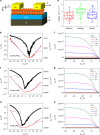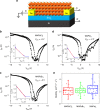Single crystal hybrid perovskite field-effect transistors
- PMID: 30559392
- PMCID: PMC6297354
- DOI: 10.1038/s41467-018-07706-9
Single crystal hybrid perovskite field-effect transistors
Abstract
The fields of photovoltaics, photodetection and light emission have seen tremendous activity in recent years with the advent of hybrid organic-inorganic perovskites. Yet, there have been far fewer reports of perovskite-based field-effect transistors. The lateral and interfacial transport requirements of transistors make them particularly vulnerable to surface contamination and defects rife in polycrystalline films and bulk single crystals. Here, we demonstrate a spatially-confined inverse temperature crystallization strategy which synthesizes micrometre-thin single crystals of methylammonium lead halide perovskites MAPbX3 (X = Cl, Br, I) with sub-nanometer surface roughness and very low surface contamination. These benefit the integration of MAPbX3 crystals into ambipolar transistors and yield record, room-temperature field-effect mobility up to 4.7 and 1.5 cm2 V-1 s-1 in p and n channel devices respectively, with 104 to 105 on-off ratio and low turn-on voltages. This work paves the way for integrating hybrid perovskite crystals into printed, flexible and transparent electronics.
Conflict of interest statement
W.Y., A.A., and L.Y. have a US patent application related to this work (Filed on 10 June 2016, WO2018047066). The remaining authors declare no competing interests.
Figures




References
Publication types
LinkOut - more resources
Full Text Sources
Other Literature Sources

